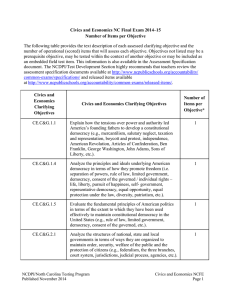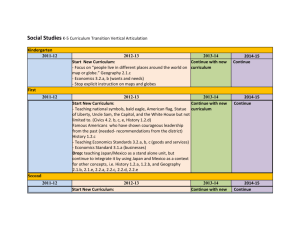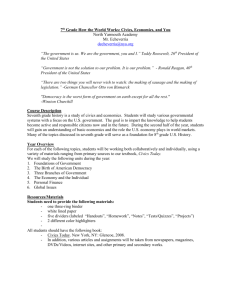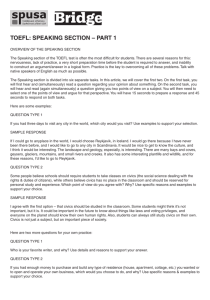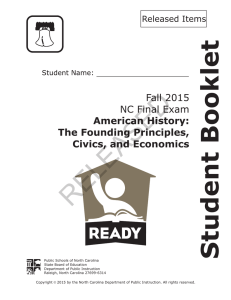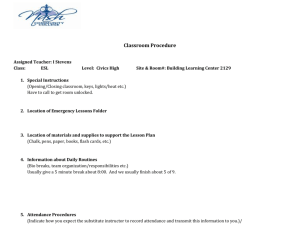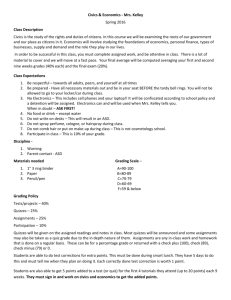American History: The Founding Principles, Civics, and Economics
advertisement
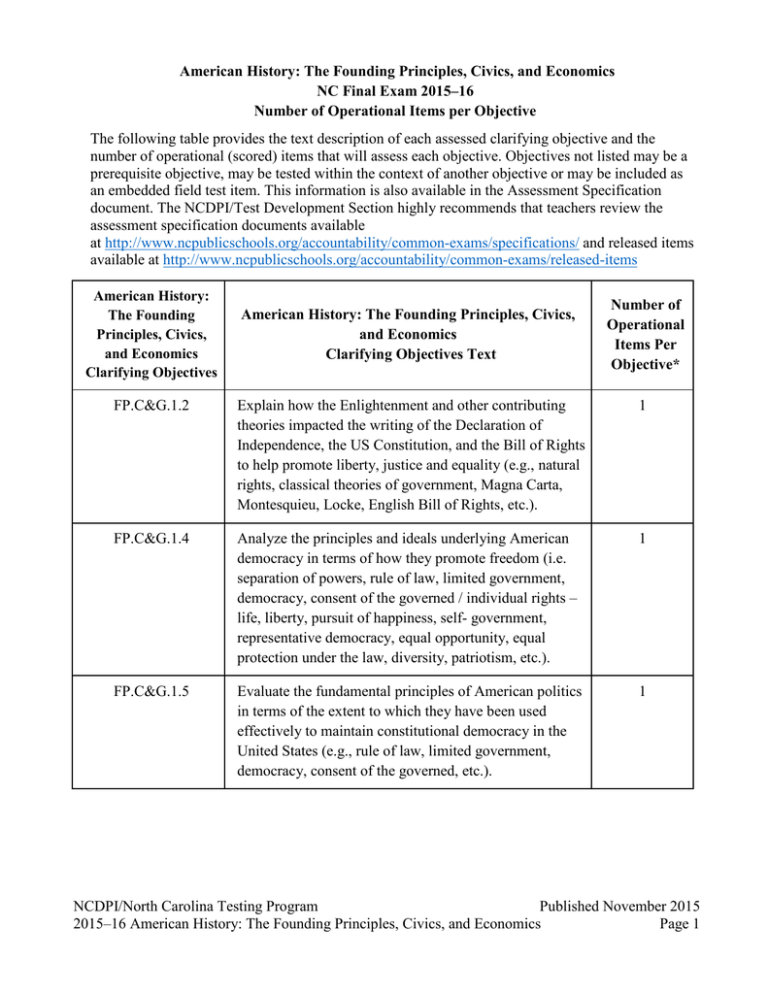
American History: The Founding Principles, Civics, and Economics NC Final Exam 2015–16 Number of Operational Items per Objective The following table provides the text description of each assessed clarifying objective and the number of operational (scored) items that will assess each objective. Objectives not listed may be a prerequisite objective, may be tested within the context of another objective or may be included as an embedded field test item. This information is also available in the Assessment Specification document. The NCDPI/Test Development Section highly recommends that teachers review the assessment specification documents available at http://www.ncpublicschools.org/accountability/common-exams/specifications/ and released items available at http://www.ncpublicschools.org/accountability/common-exams/released-items American History: The Founding Principles, Civics, and Economics Clarifying Objectives American History: The Founding Principles, Civics, and Economics Clarifying Objectives Text Number of Operational Items Per Objective* FP.C&G.1.2 Explain how the Enlightenment and other contributing theories impacted the writing of the Declaration of Independence, the US Constitution, and the Bill of Rights to help promote liberty, justice and equality (e.g., natural rights, classical theories of government, Magna Carta, Montesquieu, Locke, English Bill of Rights, etc.). 1 FP.C&G.1.4 Analyze the principles and ideals underlying American democracy in terms of how they promote freedom (i.e. separation of powers, rule of law, limited government, democracy, consent of the governed / individual rights – life, liberty, pursuit of happiness, self- government, representative democracy, equal opportunity, equal protection under the law, diversity, patriotism, etc.). 1 FP.C&G.1.5 Evaluate the fundamental principles of American politics in terms of the extent to which they have been used effectively to maintain constitutional democracy in the United States (e.g., rule of law, limited government, democracy, consent of the governed, etc.). 1 NCDPI/North Carolina Testing Program Published November 2015 2015–16 American History: The Founding Principles, Civics, and Economics Page 1 FP.C&G.2.1 Analyze the structures of national, state and local governments in terms of ways they are organized to maintain order, security, welfare of the public and the protection of citizens (e.g., federalism, the three branches, court system, jurisdictions, judicial process, agencies, etc.). 1 FP.C&G.2.4 Compare the Constitutions and the structures of the United States and North Carolina governments (e.g., the various NC Constitutions, Bill of Rights, Declaration of Rights, Preambles, the organization of, the powers of, responsibilities, etc.). 3 FP.C&G.2.8 Analyze America’s two-party system in terms of the political and economic views that led to its emergence and the role that political parties play in American politics (e.g., Democrat, Republican, promotion of civic responsibility, Federalists, Anti- Federalists, Influence of third parties, precincts, “the political spectrum”, straight ticket, canvass, planks, platform, etc.). 1 FP.C&G.3.1 Analyze how the rule of law establishes limits on both the governed and those who govern while holding true to the ideal of equal protection under the law (e.g., the Fourteenth Amendments, Americans with Disabilities Act, equal opportunity legislation). 2 FP.C&G.3.2 Compare lawmaking processes of federal, state and local governments (e.g., committee system, legislative process, bills, laws, veto, filibuster, cloture, proposition, etc.). 1 FP.C&G.3.5 Compare jurisdictions and methods of law enforcement applied at each level of government, the consequences of noncompliance to laws at each level and how each reflects equal protection under the law (e.g., Department of Justice, regulatory commissions, FBI, SBI, Homeland Security, magistrate, state troopers, sheriff, city police, ordinance, statute, regulation, fines, arrest, etc.). 1 NCDPI/North Carolina Testing Program Published November 2015 2015–16 American History: The Founding Principles, Civics, and Economics Page 2 FP.C&G.3.6 Explain ways laws have been influenced by political parties, constituents, interest groups, lobbyists, the media and public opinion (e.g., extension of suffrage, labor legislation, civil rights legislation, military policy, environmental legislation, business regulation and educational policy). 1 FP.C&G.4.1 Compare citizenship in the American constitutional democracy to membership in other types of governments (e.g., right to privacy, civil rights, responsibilities, political rights, right to due process, equal protection under the law, participation, freedom, etc.). 1 FP.C&G.4.5 Explain the changing perception and interpretation of citizenship and naturalization (e.g., aliens, Interpretations of the 14th amendment, citizenship, patriotism, equal rights under the law, etc.). 1 FP.C&G.5.1 Analyze the election process at the national, state and local levels in terms of the checks and balances provided by qualifications and procedures for voting (e.g., civic participation, public hearings, forums, at large voting, petition, local initiatives, local referendums, voting amendments, types of elections, etc.). 1 FP.C&G.5.4 Explain how conflict between constitutional provisions and the requirements of foreign policy are resolved (e.g., the power of Congress to declare war and the need for the president to make expeditious decisions in times of international emergency, the power of the President to make treaties and the need for the Senate to approve them). 1 FP.PFL.1.2 Explain how fiscally responsible individuals create and manage a personal budget that is inclusive of income, taxes, gross and net pay, giving, fixed and variable expenses and retirement (e.g., budget, financial plan, money management, saving and investing plan, etc.). 1 FP.PFL.1.5 Analyze how fiscally responsible individuals save and invest to meet financial goals (e.g., investment, stock market, bonds, mutual funds, etc.). 1 NCDPI/North Carolina Testing Program Published November 2015 2015–16 American History: The Founding Principles, Civics, and Economics Page 3 FP.PFL.1.6 Compare various investing strategies and tax implications for their potential to build wealth (e.g., individual stocks and bonds with investing in stock, giving, bonds, mutual funds, retirement plans, etc.). 2 FP.PFL.2.1 Explain how consumer protection laws and government regulation contribute to the empowerment of the individual (e.g., consumer credit laws, regulation, FTCFederal Trade Commission, protection agencies, etc.). 2 FP.PFL.2.2 Summarize various types of fraudulent solicitation and business practices (e.g., identity theft, personal information disclosure, online scams, Ponzi schemes, investment scams, internet fraud, etc.). 1 FP.PFL.2.3 Summarize ways consumers can protect themselves from fraudulent and deceptive practices (e.g., do not call lists, reading the fine print, terms and conditions, personal information disclosure, investment protection laws, fees, etc.). 1 FP.PFL.2.4 Classify the various types of insurance and estate planning including the benefits and consequences (e.g., car, health, renters, life, liability, travel, disability, longterm care, natural disaster, etc.) 1 FP.E.1.1 Compare how individuals and governments utilize scarce resources (human, natural, and capital) in traditional, command, market, and mixed economies. 1 FP.E.1.3 Explain how supply and demand determine equilibrium price and quantity produced (e.g., any market example – apples, tires, etc.). 2 FP.E.2.2 Summarize how nations specialize and become interdependent through trade (e.g., trade restrictions and government policy.) 2 FP.E.2.3 Explain the impact of government policies on international trade (e.g., tariffs, quotas, sanctions, subsidies, banking, embargos, etc.). 1 NCDPI/North Carolina Testing Program Published November 2015 2015–16 American History: The Founding Principles, Civics, and Economics Page 4 FP.E.3.1 Summarize basic macroeconomic indicators and how they vary over the course of a business cycle (e.g., gross domestic product, unemployment, consumer price index, etc.). 2 FP.E.3.2 Explain how fiscal policy and the monetary policy influence overall levels of employment, interest rates, production, price level and economic growth (e.g., business cycle, standard of living, recession, depression, Consumer Price Index, etc.). 1 FP.E.3.3 Analyze organizations in terms of their roles and functions in the United States economy (e.g., banks, labor unions, federal reserve, nonprofit organizations and cooperatives, Wall Street, etc.). 2 *Objectives not listed may be a prerequisite objective, may be tested within the context of another objective or may be included as an embedded field test item. NCDPI/North Carolina Testing Program Published November 2015 2015–16 American History: The Founding Principles, Civics, and Economics Page 5
